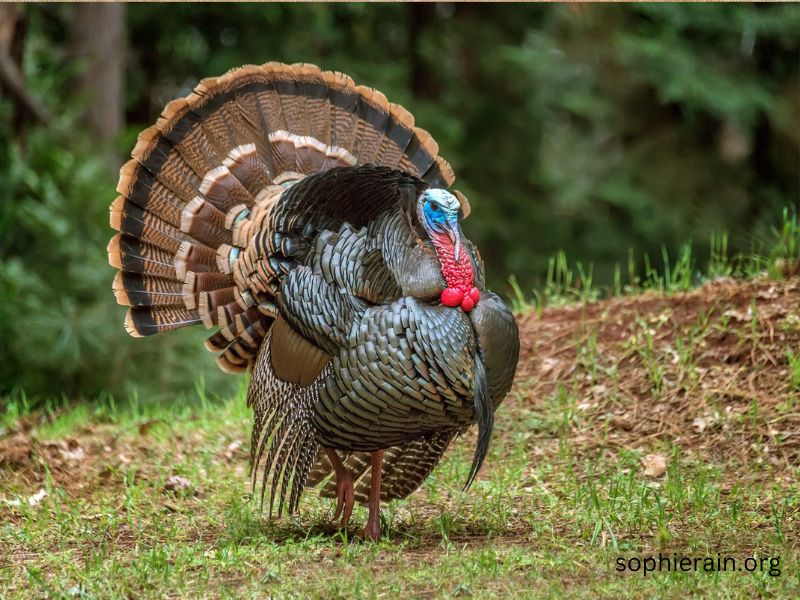The wild turkey with gold feathers, a stunning and rare sight, has intrigued bird enthusiasts and nature lovers alike. Vermont, known for its picturesque landscapes and rich biodiversity, has recently become a hotspot for sightings of this extraordinary phenomenon. These golden-feathered turkeys are not only a marvel of nature but also a symbol of Vermont’s natural beauty and its commitment to wildlife preservation. In this article, we explore the mystery of the wild turkey with gold feathers, its significance in Vermont, and the broader implications of this phenomenon on the understanding of wildlife and genetics.
The Wild Turkey: A Brief Overview
The wild turkey (Meleagris gallopavo) is native to North America and can be found across the United States, from the forests of Vermont to the plains of the Midwest. Known for their striking appearance, wild turkeys have iridescent feathers that can range in color from bronze to red and brown. Their vibrant plumage, especially the males, or toms, is often the focus of admiration among bird watchers. However, the discovery of wild turkeys with gold feathers is a relatively rare and remarkable event that has drawn considerable attention.
The Discovery of Gold Feathers in Vermont
The sighting of wild turkeys with gold feathers in Vermont has sparked curiosity and fascination. While gold-colored feathers in turkeys are not commonly observed, they have been reported sporadically in various regions across North America. In Vermont, these turkeys are typically found in rural, wooded areas where wild turkeys thrive. The first documented sighting of a wild turkey with gold feathers in Vermont occurred in a remote area near the Green Mountains. The turkey’s iridescent gold feathers stood out against the natural backdrop, creating a breathtaking and almost surreal scene.
Why Gold Feathers in Wild Turkeys Are So Rare
Gold feathers in wild turkeys are a rare genetic mutation, making them an exceptional sight in the wild. While wild turkeys naturally display a range of colors, including bronze, copper, and green, the gold variation occurs due to specific genetic factors that affect feather pigmentation. These mutations alter the way light interacts with the feather structure, resulting in a golden hue.
In most cases, these golden feathers are not widespread within turkey populations. Instead, they tend to occur sporadically, affecting only a small percentage of turkeys within a given area. The rarity of gold-feathered turkeys adds to their allure, making them highly sought after by birdwatchers and photographers alike.
The Significance of Gold Feathers in Wild Turkeys
The discovery of gold-feathered turkeys in Vermont holds both aesthetic and scientific significance. From an aesthetic perspective, these turkeys are a remarkable sight to behold. The golden feathers shimmer in the sunlight, creating a dazzling effect that captivates all who encounter them. Their rarity and striking appearance make them an iconic representation of Vermont’s natural beauty, attracting nature enthusiasts and tourists to the region.
From a scientific perspective, the appearance of gold feathers in wild turkeys provides valuable insight into the complexities of genetics and pigmentation in birds. The study of these mutations can help researchers better understand the mechanisms that govern feather color and pattern formation in birds. Additionally, the gold-feather mutation in wild turkeys may offer clues about how genetic mutations arise in wild populations and how they are passed down through generations.
How Vermont’s Natural Environment Contributes to the Phenomenon
Vermont’s diverse and pristine natural environment plays a key role in the emergence of rare wildlife phenomena such as the gold-feathered wild turkey. The state is home to a variety of ecosystems, including dense forests, wetlands, and open fields, all of which provide ideal habitats for wild turkeys. These habitats offer abundant food sources, shelter, and space for turkeys to roam freely.
The Green Mountains, a central feature of Vermont’s landscape, provide a particularly rich environment for wildlife. These mountains are home to a wide range of plant and animal species, including wild turkeys, which thrive in the area’s mixed forests and wetlands. The mountainous terrain offers a variety of microhabitats, which may contribute to the genetic diversity seen in turkey populations.Wild turkeys, as omnivores, play an important role in controlling insect populations and dispersing seeds, which contributes to the overall health of the ecosystem. In this sense, the appearance of gold-feathered wild turkeys in Vermont serves as a reminder of the state’s commitment to environmental conservation and wildlife preservation.
The Role of Genetics in Feather Coloration
The color of feathers in wild turkeys is primarily determined by genetic factors that influence the production of pigments. Wild turkeys typically have feathers that exhibit iridescence, with hues ranging from bronze to copper and green. These colors are the result of microscopic structures within the feathers that refract light in different ways, creating a shimmering effect.
In the case of the gold-feathered wild turkey, the pigmentation process is altered due to a genetic mutation. This mutation affects the way light interacts with the feather structure, resulting in a golden hue rather than the typical colors found in wild turkey feathers. While the exact genetic mechanism behind the gold feather mutation is not yet fully understood, it is believed that it is a recessive trait, meaning that both parents must carry the gene for the mutation to be expressed in their offspring.
The rarity of the gold-feathered mutation is due to the fact that the gene responsible for this coloration is uncommon in wild turkey populations. However, as more turkeys are observed in the wild, it is possible that additional cases of gold-feathered turkeys will be discovered.
Conservation Efforts and the Future of Wild Turkeys in Vermont
Vermont has a long history of conservation efforts aimed at preserving its wildlife and natural habitats. The state’s Department of Fish and Wildlife works tirelessly to protect native species, including the wild turkey, by implementing sustainable management practices and habitat restoration projects.
The appearance of gold-feathered turkeys in Vermont serves as a reminder of the importance of these conservation efforts. As rare genetic mutations such as this one become more visible, they highlight the need for continued protection of Vermont’s ecosystems. By maintaining healthy habitats and promoting biodiversity, Vermont ensures that future generations will be able to witness the beauty of these extraordinary animals.
Conclusion: A Symbol of Vermont’s Natural Beauty
The wild turkey with gold feathers in Vermont is a rare and captivating phenomenon that has captured the attention of nature lovers, scientists, and conservationists alike. These golden-feathered turkeys symbolize the rich biodiversity of the region and serve as a reminder of the importance of preserving natural habitats. As researchers continue to study the genetic mutations that produce these extraordinary birds, they unlock new insights into the complexities of wildlife and evolution. Whether you are a birdwatcher or simply a lover of nature, encountering a wild turkey with gold feathers in Vermont is an experience that is truly unforgettable.






